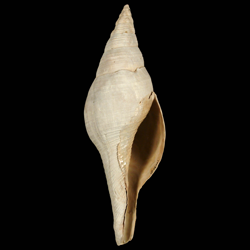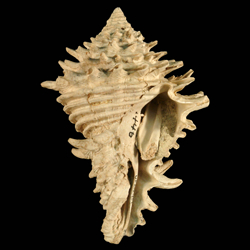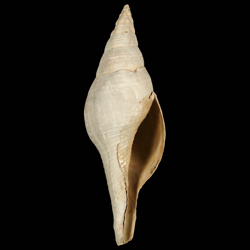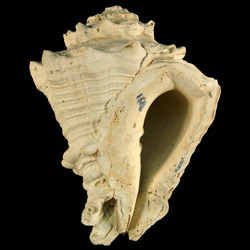
Turbinellidae

- Phylum: Mollusca
- Class: Gastropoda
- Order: Neogastropoda
- Family: Turbinellidae
Overview
Common name: Chank, trumpet, and vase shells
Key morphological features: The Turbinellidae are medium to large-sized gastropods with predominantly pyriform or spindle-shaped, solid, heavy shells. The Turbinellidae have moderate to high-spired shells with medium to long siphonal canals. Exterior sculpture is variable, ranging from smooth to spiral cords and/or axial ribbing, including nodes and spines in some species. The aperture shape is most often open and more or less ovate in outline. The labrum profile may be straight or curved and the interior surface may be smooth or reflect exterior sculpture. The columella is smooth in some species but may exhibit one to five folds in others. Source: Davies, A.M. 1971. Tertiary Faunas Vol. 1, second edition. New York: American Elsevier Publishing Company, Inc. 571 pp.
Geological range: Upper Cretaceous to Recent (Davies, 1971).
Geographic distribution: A distributional map for modern Turbinellidae may be accessed from OBIS. A distributional map for ancient Turbinellidae may be accessed from the Paleobiology Database.
Diversity: There are 91 recognized living species of Turbinellidae and 13 genera (WoRMS database, unvetted). The Paleobiology Database recognizes 17 fossil genera and 147 fossil species of Turbinellidae (unvetted).
Paleoecology: The extant Turbinellidae are marine predatory gastropods that prey predominantly on polychaete worms and bivalves. The Turbinellidae inhabit predominantly soft sediments ranging in depth from the intertidal to over 200m depth. Most species are found at tropical or subtropical latitudes around the world, but some species ranges extend to higher latitudes. This family includes the largest living gastropod: Syrinx aruanus, the Australian trumpet snail, the shell of which can reach lengths of up to a meter. Sources: Tunnell et al. (2010); Harasewych, M.G., Moretzsohn, F. 2010. The book of shells. Chicago: The University of Chicago Press. 656 pp.
Phylogenetic status: Unknown.


